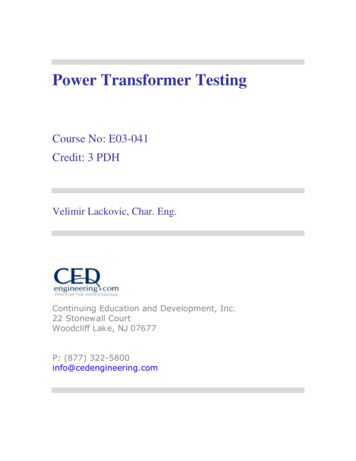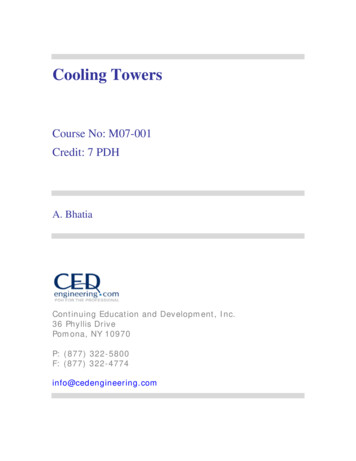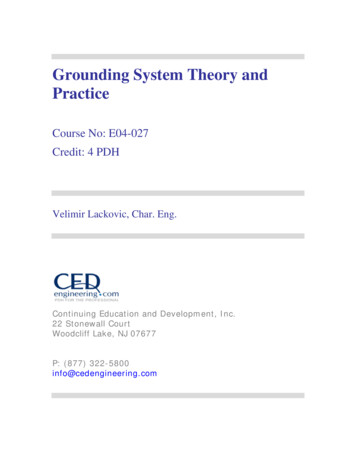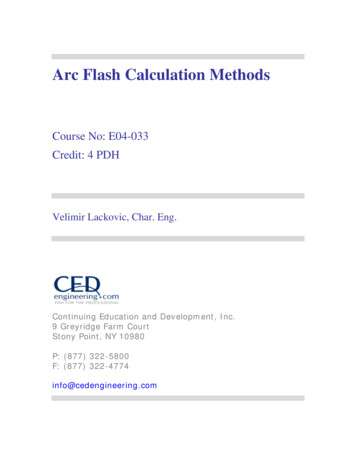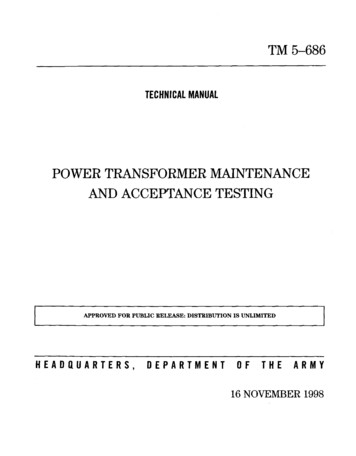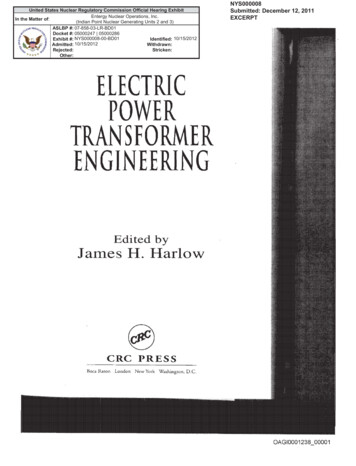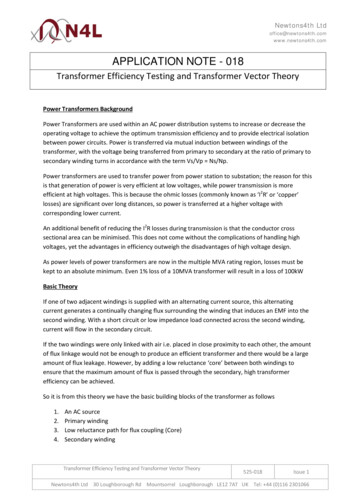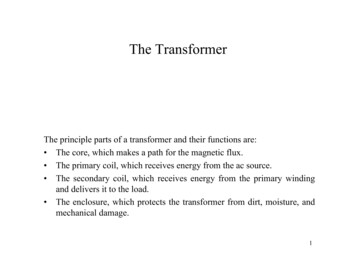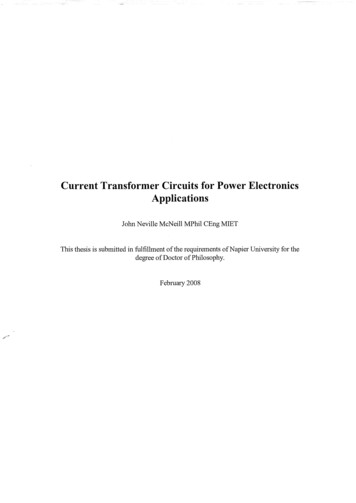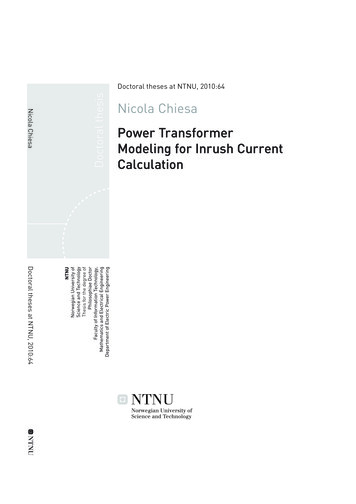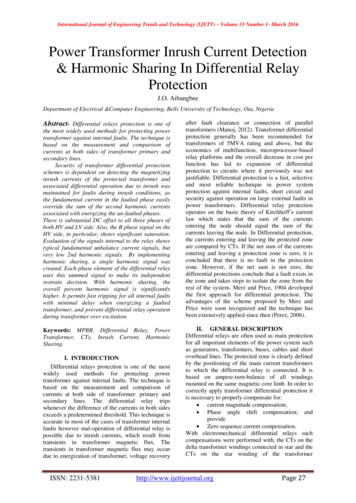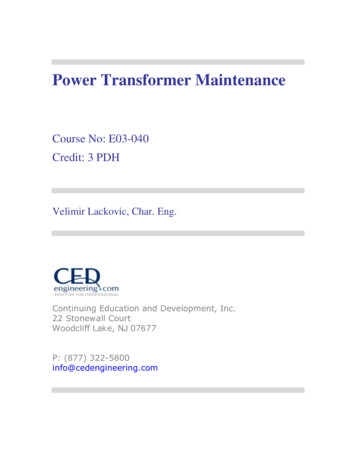
Transcription
Power Transformer MaintenanceCourse No: E03-040Credit: 3 PDHVelimir Lackovic, Char. Eng.Continuing Education and Development, Inc.22 Stonewall CourtWoodcliff Lake, NJ 07677P: (877) 322-5800info@cedengineering.com
POWER TRANSFORMER MAINTENANCEThe objective of this course is to outline the suggested work procedures that aretypically performed for transformer preventive maintenance. The suggestedprocedures presented in this course do not pertain to the major overhaul andtransformer repair. Nevertheless, many procedures completed during routinemaintenance and transformer major overhaul may be the same. The maintenanceroutines discussed in this section can be applied to a transformer that has notreached an advanced deterioration stage. Also, these suggestions are written for theaverage circumstances under which the transformer is required to work. It is furtherimplied that all staff involved with the maintenance are adequately trained and havetransformer maintenance experience. The suggested practices presented in thiscourse are similar to those that manufacturers suggest for their equipment. Ifdetailed instructions are needed, the student needs to consult manufacturermanuals. Transformer preventative maintenance involves routine inspection,adjustment, testing, minor fixes, and special handling instructions. Also, the troublefree service of the equipment over its life depends on proper installation, operation,and maintenance.Power Transformer Installation, Acceptance, and Maintenance ProceduresTransformer successful operation depends on correct installation, loading, andmaintenance. Also it depends on proper design and manufacture. As is with allelectrical devices, neglecting of certain requirements may lead to severe problems, ifnot to the equipment loss. The objective of transformer maintenance process can besummarized as follows:Unscheduled Transformer MaintenanceThis philosophy is based on reactionary operation mode. That is to say, maintain theequipment when it breaks down, otherwise do not take any actions.Transformer Ordinary MaintenanceThis philosophy considers making irregular visual inspection and doing repairs,adjustments, and necessary replacements.
Protective MaintenanceThis approach consists of completing preventive, predictive and correctivemaintenance. The preventive maintenance involves schedule maintenance andregular testing. Predictive maintenance involves extra monitoring and testing,whereas corrective maintenance considers repairing and restoring transformerintegrity to its original condition when degraded conditions are found. The goal of thetransformer protective maintenance is to control and prevent serious oil and windinginsulation deterioration. Mineral oil and winding paper insulation are impacted bymoisture, oxygen, heat, and other agents such as copper, iron, electric stress, etc.The end result is that oxidation happens in the oil which leads to transformersludging. In sealed units ingress of moisture via atmosphere or seal leaks needs tobe stopped. Moisture will decrease the dielectric strength of both the oil and thewinding insulation systems. Also, transformer extra heating will cause the windinginsulation (paper) to decompose which in-turn creates moisture. Increased moisturecreated in the paper not only decreases the paper insulating strength but also, astemperature increases, the moisture will migrate from the paper insulation to the oiland decrease its dielectric strength. The most important step is to constructtransformers so that moisture and oxygen are kept out. The next step is to operatetransformers so that they are not operated beyond their temperature ratings andlimits. Also, the severity of deterioration needs to be controlled by periodicallymonitoring and testing transformer insulation, and take mitigation measures torestore transformer to its original condition. This approach can be summarized by thefollowing:1. Measure and control transformer heat2. Inspect and maintain transformer auxiliary elements3. Test and maintain transformer insulation4. Maintain transformer bushing insulation5. Maintain transformer protective coating
These points are discussed next under installation, maintenance and transformertesting. The transformers are divided into dry and liquid types for the purposes of thiscourse.Dry-Type Power TransformersInstallationFactors that need to be clearly kept in mind when installing dry-type transformers areaccessibility, ventilation, and atmospheric conditions. Ventilated dry-type powertransformers are typically designed for application indoors in dry locations. They willwork successfully where the humidity may be high, but under this condition it may bemandatory to take precautions to keep them dry if they are shut down for appreciableperiods. Areas where there is dripping water need to be avoided. If this is notpossible, adequate protection needs to be provided to stop water from entering thetransformer enclosure. Precautions need to be taken to guard against accidentalwater entrance, such as might happen from an open window, by a break in a wateror steam line, or from use of water near the transformers. Proper ventilation ismandatory for the adequate transformer cooling. Clean, dry air is recommended.Filtered air may decrease maintenance if the location presents a particular issue.When power transformers are installed in vaults or other restricted locations,adequate ventilation needs to be given to keep the air temperature within establishedlimits when measured near the transformer inlets. Typically, this requires a minimumof 100 ft3 of air per minute per kilowatt (kW) of transformer loss. The area of neededventilating openings depends on the vault height. For self-cooled powertransformers, the needed effective area needs to be at least 1 ft. for each inlet andoutlet per 100 kVA of transformer rated capacity, after deduction of the areaoccupied by screens, gratings, or louvers. Ventilated dry-type transformers need tobe installed in areas free from unusual dust-producing mediums or chemical fumes.Transformers above 75 kVA need to be placed at least 12 in. from walls or otherobstructions that might prevent free air circulation through and around each unit. Thedistance between adjacent power transformers must not be less than this figure.Smaller transformers can be directly installed on the wall but still need to be mountedat least 12 in. apart. Also, accessibility for maintenance needs be taken into accountin locating a transformer. If the transformer is to be placed near combustible
materials, the minimum clearances established by the National Electrical Code(NEC) need to be kept. The transformer enclosure is made to stop the entrance ofmost small animals and foreign objects. Nevertheless, in some areas it may bemandatory to give consideration to extra protection. Typically, a flat, level industrialfloor is adequate and no special preparation is required because of the baseconstruction used on these transformers, which completely eliminates the process ofgrouting sills into concrete floors. If noise is a factor in the location and operation ofany power transformer, special consideration needs to be given to the equipmentinstallation. The transformer impulse strength is less than that of liquid immersedunits of the same voltage class. If there is any chance that transformers will beexposed to lightning or serious switching surges, proper protective equipment needsto be provided. Transformers of standard temperature rise are made to function ataltitudes up to and including 3300 ft. Dry-type transformers depend on air fordissipation of their heat losses; consequently, the effect of decreased air density dueto high altitude will increase the transformer temperature. Typical transformers canbe used at altitudes higher than 3300 ft. if the load to be carried is decreased belownameplate rating as follows: If the power transformer is dry type, self-cooled, classAA, decrease the nameplate rating by 0.3% for each 330 ft. above the altitude of3300 ft. If the transformer is dry type, forced air cooled, class AA/FA, decrease thenameplate rating by 0.5% for each 330 ft. above the altitude of 3300 ft. If themaximum 24 h average temperature of the cooling air is decreased below designlevels, the altitude limitation of 3300 ft. can be safely surpassed without decreasingthe transformer nameplate rating within the limitations of Table 1.Table 1. Maximum 24h average cooling air temperature ( C)AltitudeType of apparatus3300 ft. 6600 ft. 9900 ft. 13200 ft.Dry type, class AA80 C rise30262218115 C rise30241812150 C rise3022157Dry-type, class AA/FA80 C rise115 C rise150 C rise30303022181514706-5-15
Transformer InspectionNew power transformers should be inspected for damage during transport once theyare received. Inspection has to be made before removing from cars or trucks, and ifany damage is evident or any indication of rough handling is noticeable, a claimneeds to be filled with the carrier at once and the manufacturer has to be informed.Subsequently, covers should be removed and an internal inspection made fordamage or displacement of parts, loose or broken elements, cracked porcelain, dirtor foreign material, and for the presence of free water or moisture. Corrective actionshave to be if necessary. Shipping braces need to be removed if provided. After atransformer is moved, or if it is stored before installation, this examination needs tobe repeated before placing the transformer in operation.After arranging all the necessary primary and secondary connections, thetransformer needs to be thoroughly examined. Before putting in operation, theoperation of fans, motors, thermal protection relays, and other auxiliary elements hasto be verified. All bolted connections that may have loosened in shipment must betightened before putting in service. The case and core assembly of powertransformers needs to be permanently and properly earthed.Transformer Acceptance TestsOnce the transformer has been installed, the following tests should be completed foracceptance:Insulation resistance (IR) test: The IR examination is of value for futurecomparative needs and also for determining the suitability of the power transformerof energizing or application of the high-potential (hi-pot) test. The IR test needs to besuccessfully passed for factory warranty to be valid. The IR test needs to be carriedimmediately prior to energizing the transformer or beginning the high potential test.Obtained figures, corrected to factory test temperature of 20 C, need to be equal toor higher than the figures presented in the Table 2, or a minimum of one half or moreof factory test figures. In the case corrected test values at 20 C are less than theminimum of the above figures, than the transformer insulation condition isquestionable.
Table 2. Dry-type transformer IR figuresTransformer Coil Minimum DCMinimum IR (MΩ)Rating Type (V)Test Voltage Dry Type Transformer0-6001000500601-500025005000Higher than 5000500025000In the absence of previous reliable test figures, the following expression can be usedfor single-phase transformers, or single winding of a three-phase transformer forcalculating the IR values.𝐼𝑅 𝐶𝐸 𝑘𝑉𝐴whereIR is the minimum 1min 500 V DC IR in MΩ from winding to earth, with other windingor windings guarded, or winding to winding with core guardedC - 30 at 20 C measurements (C 16 for tests of winding with other winding orwindings earthed)E - voltage rating of winding under testkVA - rated capacity of winding under testIf the transformer under test is three-phase type, and all three individual windings arebeing tested as one, then:E is the voltage rating of one of the single-phase windings (line-to-line for deltaconnected units and line-to-neutral for star-connected units)kVA - the rating of the three-phase winding under testPolarization index (PI) test: This is an addition to IR test. In this test, the two IRmeasurements are completed, the first reading at 1min and the second reading at 10min. Then the ratio of the 10min reading to 1min reading is calculated to give the PIdielectric absorption value.
A PI of winding-to-winding and winding-to-earth has to be found. A PI less than 2 isindicative of insulation deterioration and requires additional checks.AC hi-pot (dielectric) test: The dielectric test puts a stress on the insulation sincethe dielectric test voltage is bigger than the normal voltage. The IR test has to besuccessfully passed immediately before completing the dielectric test to prevent thepossibility of transformer damage due to moisture. The dielectric test supplementsthe IR tests by checking the transformer suitability for operation at rated voltage.Field test voltages should not surpass 75% of factory test values. The hi-pot test setneeds to be variable to allow a gradual increase of test voltage from zero and agradual decrease after the test is finished. These test figures are presented in Table3.Table 3. Dielectric test value for acceptance and periodic maintenance of dry-typepower transformersTransformer, windingrated, AC voltage(kV)1.2 and below2.44.164.86.97.28.3212.012.4713.213.8Factory test,AC voltage(kV)410121219191931313131Acceptance fieldtest, AC voltage(75%) 5Maintenance periodictest, AC voltage 520.15Transformer turns ratio (TTR) test: The TTR test is used to check transformerturns ratio. It measures the number of turns of the primary winding with respect tothe number of turns in secondary winding. The accepted values of the TTR testshould not be higher than 0.5% as compared with calculated figures.Insulation power factor (PF) (dissipation factor) test: This test measures the wattloss in the tested insulation. Since it is an AC voltage test, it precisely indicates thewetness of the winding insulation and corona issues. This verification can be
completed as PF tip-up test for dry type power transformers to further distinguishbetween a moisture or carbonization issues.MaintenanceSimilarly to other electric devices, these transformers need maintenance from time totime to assure successful service. Inspection has to be done at regular intervals andcorrective actions need to be taken when necessary to assure the most satisfactoryoperation of this equipment. The frequency of inspection depends on operatingconditions. For clean, dry areas, an inspection annually, or after a longer period, maybe fine. Nevertheless, for other areas, such as may be encountered where the air ispolluted with dust or chemical fumes, an inspection at 3 or 6 month intervals may beneeded. Typically, after the first few inspection periods, final schedule can be madebased on the existing conditions. Once the transformer is de-energized, covers overopenings need to be removed. Inspections have to be made for dirt, especiallyaccumulations in insulating surfaces or those which tend to prevent air flow, for looseconnections, for the condition of tap changers or terminal boards, and for the generaltransformer condition. Observation has to be made for signs of overheating and ofvoltage creepage over insulating surfaces, as evidenced by carbonization tracking.Signs of rust, corrosion and deterioration of the paint need to be checked andmitigation measures taken if required. Fans, motors, and other auxiliary elementsshould be inspected and maintained.Cleaning: If significant accumulations of dirt are found on the transformer windingsor insulators when the transformer is checked, the dirt has to be removed to allowfree air circulation and to guard against the possible insulation breakdowns. Specialattention has to be given to cleaning top and bottom ends of winding assemblies andto cleaning out ventilating ducts.The windings may be cleaned with a vacuum cleaner, blower, or with compressedair. The use of a vacuum cleaner is preferred as the first step in cleaning, followed bythe use of compressed air or nitrogen. The compressed air or nitrogen should beclean and dry and should be used at a relatively low pressure. Lead supports, tapchangers and terminal boards, bushings, and other major insulating surfaces have tobe brushed or wiped with a dry cloth. The application of liquid cleaners is not
recommended since some of them have deteriorating effect on most insulatingmaterials.Testing for routine maintenance: These tests are needed for routine maintenanceof dry-type power transformers.-IR test of winding-to-winding and winding-to-earth - This test is similar to thetest listed under installation and acceptance.-Dielectric absorption test needs to be done winding-to-winding and windingto-earth for 10 min. The PI needs to be above 2.0 for acceptable limits.-Turns ratio test (TTR) needs to be completed similarly to that underinstallation and acceptance.-AC over-potential test should be done on all high- and low-voltage windings-toearth. This is an optional test for routine maintenance testing.-Insulation PF test can be completed for each winding-to-earth and winding-towinding. The acceptable value is lower than 3%.Drying-Out TechniquesFor the purpose of drying out, power transformers can be considered as consistingof core and coil assembly. When it is mandatory to dry out a transformer beforeinstallation or after an extended shutdown under relatively high humidity, one of thefollowing techniques may be used:-External heat-Internal heat-External and internal heatBefore using any of these techniques, free moisture has to be blown or wiped off thewindings to decrease the time of the drying period.
Drying by external heat - External heat may be brought to the transformer by oneof the following techniques:-By directing heated air into the bottom air inlets of the transformer enclosure-By putting the core and coil assembly in a non-flammable box with openingsat the top and bottom through which heated air can flow-By putting the core and coil assembly in a properly ventilated oven-By putting incandescent lamps in the transformer containerIt is crucial that most of the heated air is blown through the winding ducts and notaround the sides. Proper ventilation is vital in order that condensation does not takeplace in the transformer itself or inside the enclosure. A sufficient quantity of air hasto be used to assure roughly equal inlet and outlet temperatures. When using eitherof the first two external heating methods heat may be obtained by the application ofresistance grids or space heaters. These may either be placed inside the case orbox or may be put outside and the heat blown into the bottom of the enclosure. Thecore or coil assembly has to be carefully protected against direct radiation from theheaters. It is suggested that the air temperature does not exceed 110 C.Drying by internal heat - This technique is quite slow and should not be used in thecase other methods are available. The transformer needs to be installed so that itallows free air circulation through the coils from the bottom to the top of theenclosure. One winding needs to be short circuited and sufficient voltage at normalfrequency needs to be applied to the other winding to circulate roughly normalcurrent.It is suggested that the winding temperature does not exceed 100 C, as measuredby resistance or by thermometers installed in the ducts between the windings. Thethermometers need to be of the spirit type, since mercury thermometers giveerroneous readings due to the heat generation in the mercury as a result of inducededdy currents. The terminal end windings (and not the taps) have to be used in orderto circulate current through the entire winding. Adequate precautions have to be
taken to save the operator from dangerous voltages.Drying by external and internal heat - This technique combines two methods thatare previously described. It is also the quickest technique. The transformer core andcoil assembly need to be installed in a non-flammable box, or kept in its own case ifappropriate. External heat is applied as described in the first technique, and currentis circulated through the windings as described in the second technique. The neededcurrent will be considerably less than when no external heating is applied but has tobe sufficient to generate the desired winding temperature. It is suggested that thetemperatures attained do not surpass those stated in previous two techniques.Drying time is dependent on the transformer condition, size, voltage, amount ofabsorbed moisture and the used drying method. The measurement of IR is useful indetermining the drying status. Measurements have to be completed before startingthe drying process and at 2 h intervals during drying. The starting value, if taken atordinary temperatures, may be bigger even though the insulation may not be dry.Because IR changes inversely with temperature, the transformer temperature has tobe kept roughly constant during the drying period to get comparative readings. Asthe transformer is heated, the moisture presence will be evident by the quick drop inresistance measurement. Following this period the IR will increase gradually untilnear the end of the drying period, when it will increase more quickly. Sometimes itwill increase and fall through a short range before steadying, since moisture in theinterior of the insulation is working out through the initially dried portions. IRmeasurements need to be completed for each winding-to-earth, with all windingsearthed except the one being examined. Before completing IR measurements, thecurrent has to be interrupted and the winding needs to be short circuited and earthedfor at least 1 min to drain off any static charge. All readings need to be for the sametime of application of test voltage, preferably 1 min. Constant attendance during thedrying process is recommended.StorageVentilated dry-type power transformers preferably need to be stored in a warm dryarea with constant temperature. Ventilating openings need to be covered to keep outdust. In the case it is mandatory to leave a transformer outdoors it has be properly
protected to stop moisture and foreign material from entering. Condensation and themoisture absorption can be prevented or decreased by the immediate installation ofspace heaters or other small electric heaters. In the case it is more convenientincandescent lamps may be substituted for the space heaters.Liquid-Type Power TransformerThe following section presents general recommendations for installation andmaintenance of liquid-filled power transformers. Many points listed for dry-typepower transformers can be also applied to liquid-filled power transformers and willnot be additionally discussed.InstallationThe transformer has to be installed in line with National Fire Protection Association(NFPA) Document 70, NEC Article 450. Because of the ban on askarel for use as atransformer insulating fluid, liquids such as silicone, RTemp, and others are beingused. These liquids have a fire point of not less than 300 C and the NEC hasclassified these fluids as less flammable. The oil filled power transformers, if placedindoor need to be installed in a fire proof vault in line with NEC Article 450. Hence,they are typically installed outdoors with an oil pit (oil containment enclosure) filledwith gravel or stones to contain the oil in case of spill. The gravel and stones areused to inhibit the oil from pooling in case of fire. It is crucial that local and NECregulations are followed when installing transformers filled with these fluids.Important factor for transformer installation is ventilation. Proper ventilation needs tobe provided in transformer rooms and vaults to carry transformer heat away. Selfcooled transformers need to have proper (2 to 3 ft.) space between each unit toallow free air movement. The ventilation needs to be dust-free, dry, andnoncorrosive, and should not contain any detrimental pollutants. As with dry-typepower transformers, precautions need to be taken to stop leakage of water intotransformer rooms. The power transformer needs to be permanently earthed bymeans of 4/0 cable or larger to the substation earthing bus. The power transformerneeds to be protected against lightning and other overvoltage conditions by suitablelightning arresters.
InspectionNew power transformers need to be examined when received for damage that mayoccur during transport. Examination needs to be done before unloading from theshipping carrier for indication of improper handling and injury to the transformer.After the power transformer is unloaded from the truck or railcar, an internalexamination needs to be made for displacement of elements, broken or looseconnections, dirt or foreign material, and the presence of water or moisture. In thecase oil or transformer fluid was installed at the factory examine the powertransformer for leaks. Also verify for positive gas pressure if the power transformer isequipped with an inert gas. Verification needs to include the examination of thetransformer enclosure, bushings, anchor and tie rods, earthing straps, drains,covers, valves, and other elements that are provided with the transformer. If internaltransformer tank inspection has to be done, ensure there is sufficient ventilation inthe transformer tank before entering the tank. It is vital that there is at least 16%oxygen content before entering the transformer tank. The inspection port cover mustnot be opened under wet conditions. It is recommended practice not to expose thetransformer liquid to the atmosphere if the relative humidity is above 65%.Power Transformer Acceptance TestsBefore a power transformer is energized, it needs to pass following acceptancetests:IR test - The IR test is useful for checking if the transformer is in good condition andalso to make a benchmark for future comparative tests. The measured IR values area function of temperature, whether the coils are immersed in the transformer liquid ornot, or whether the windings are cold or hot. The measured values need to becorrected to 20 C by multiplying them by proper correction factors. The technique ofmeasuring IR by a megohm-meter indicates the IR directly in million of ohms (ormegohms). This technique has a minimum voltage range that is presented in Table4. It is suggested for the different voltage rated transformers.
Table 4. Liquid-filled transformer IR figuresTransformer Coil Minimum DC Minimum IR (MΩ) –Rating Type (V)Test Voltage Liquid-filled transformer0-6001000100601-500025001000Higher than 5000 50005000In the absence of consensus regulations on what constitutes a proper IR value, theNation Electrical Testing Association (NETA) recommends the values of Table 4 tobe used for acceptance and maintenance transformer testing. The measured IRvalues have to be compared to factory test values if available for purposes ofevaluating the results. It is recommended to watch for the trend to determine if themeasured values keep stable or are heading downward. Even though the measuredvalues may be above the minimum figure, a downward trend over a period of timemay suggest changes which require further investigation. In the absence of reliableprevious test information, the following expression may be used for single-phasetransformers, or single transformer winding of three-phase power transformer𝐼𝑅 𝐶𝐸 𝑘𝑉𝐴whereIR is the minimum 1min 500 V DC IR in megohms from winding-to-earth, with otherwinding or windings guarded, or winding-to-winding with core guardedC 30 at 20 C measurements (C 0.8 for tests of winding with other winding orwindings earthed)E is the voltage rating of tested windingkVA is the rated capacity of tested windingIn the case transformer under test is of the three-phase type, and all three individualwindings are being examined as one, then:E is the voltage rating of one of the single-phase windings (phase-to-phase for deltaconnected units and phase-to-neutral for star-connected units).
kVA is the rating of the tested three phase windingInsulating liquid dielectric test - The insulating liquid needs to be sampled in linewith ASTM D-923 standard and checked for determination of its dielectric strength,acidity, moisture, interfacial tension, color, and PF. These verifications are done toensure that the insulating liquid has not changed from its established levels or thatthe dielectric strength has not been decreased through accumulation ofcontaminants and pollutants. The samples for oil are taken from the bottom of thetransformer tank, while the samples for askarel and silicone are taken from the top ofthe tank.TTR - The TTR test is done to ensure that the transformer turns ratio is correct andthat none of the transformer windings are shorted out. Essentially, it compares thenumber of turns in winding 1 with the number of turns in winding 2. The test needs tobe completed for each tap position for transformers equipped with tap changers.The TTR test can also check transformer polarity. The TTR test value for acceptancemust not be higher than 0.5% when compared to calculated values.Hi-pot test - The hi-pot test (also known as the over-potential test) needs to becompleted on all high- and low-voltage windings of the transformer to earth. EitherAC or DC voltage can be applied. Nevertheless, the accepted practice is to useeither an AC or DC hi-pot test to transformers up to 34 kV. For transformers above34 kV, only the AC hi-pot test is used. For transformer acceptance, the AC hi-pot testcan be used at rated transformer voltage for 3 min. This is a go or no-go test. In thecase hi-pot voltage is held without any failure or transformer malfunction, thetransformer is considered to have successfully passed the test.PF (dissipation factor) test - This test needs to be completed on important and/orlarge power transformers. This test stresses the insulation in proportion to thestresses generated in normal operation because it is an AC volt
Power Transformer Installation, Acceptance, and Maintenance Procedures. Transformer successful operation depends on correct installation, loading, and maintenance. Also it depends on proper design and manufacture. As is with all electrical devices, neglectin
